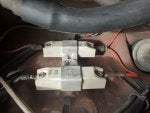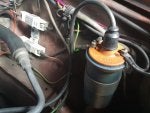Hello gals and gents,
My 1979 450SL has been challenging to cold start over the last few weeks / months and finally gave up yesterday; engine cranks but she just won't fire up. This was a very random and intermittent issue so difficult to pinpoint what was going awry. Now that she’s come to a standstill I’ve checked and confirmed that fuel is delivered to injectors and cold start valve, and that plugs have sparks. However, while cranking the cold start valve doesn’t get any voltage and therefore doesn’t spray fuel: I think this is the likely culprit and it’s a million dollar question why there’s no juice flowing. I’ve replaced the fuel pump and cold start relay (top left and top right relays) with new ones, however that made no difference. My friendly electrics guru is on holidays and it will be Sep 14th before we investigate this further.
While exploring electrics I’ve noticed that the ignition coil could use replacing and that there should be a 0.6 and 0.4Ohm ballast resistors connected, A0001581345 silver and A0001582045 blue respectively. In my car, both are silver 0.6Ohm – see pics below please - and while this may have no impact on the start-up issue I’d like to correct this set up. Apologies for the first two pics being upside down, no matter how I upload them they change the orientation. At any rate the challenge is that I don’t know which silver resistor, top or bottom, should be swapped for the blue one, so the favour I’d like to ask – could someone kindly post a pic of what their config / wiring looks like? I've searched the forum and found a couple of threads, but they revolve around earlier SL's with D Jetronic rather than K Jet so I thought I'd spin a new thread in case it matters.
In the meantime I also ordered a new rotor arm, distributor cap and spark plugs – all were replaced in 2012 / 5k miles ago. Battery is healthy / full, I replaced it two years ago.
Any tips / guidance / advice much welcome and highly appreciated.
My 1979 450SL has been challenging to cold start over the last few weeks / months and finally gave up yesterday; engine cranks but she just won't fire up. This was a very random and intermittent issue so difficult to pinpoint what was going awry. Now that she’s come to a standstill I’ve checked and confirmed that fuel is delivered to injectors and cold start valve, and that plugs have sparks. However, while cranking the cold start valve doesn’t get any voltage and therefore doesn’t spray fuel: I think this is the likely culprit and it’s a million dollar question why there’s no juice flowing. I’ve replaced the fuel pump and cold start relay (top left and top right relays) with new ones, however that made no difference. My friendly electrics guru is on holidays and it will be Sep 14th before we investigate this further.
While exploring electrics I’ve noticed that the ignition coil could use replacing and that there should be a 0.6 and 0.4Ohm ballast resistors connected, A0001581345 silver and A0001582045 blue respectively. In my car, both are silver 0.6Ohm – see pics below please - and while this may have no impact on the start-up issue I’d like to correct this set up. Apologies for the first two pics being upside down, no matter how I upload them they change the orientation. At any rate the challenge is that I don’t know which silver resistor, top or bottom, should be swapped for the blue one, so the favour I’d like to ask – could someone kindly post a pic of what their config / wiring looks like? I've searched the forum and found a couple of threads, but they revolve around earlier SL's with D Jetronic rather than K Jet so I thought I'd spin a new thread in case it matters.
In the meantime I also ordered a new rotor arm, distributor cap and spark plugs – all were replaced in 2012 / 5k miles ago. Battery is healthy / full, I replaced it two years ago.
Any tips / guidance / advice much welcome and highly appreciated.




















